April 21, 2024
It is only 337 miles from Budapest, Hungary to Dubrovnik, Croatia. We had
hoped to take a train, but it’s an 18-hour train/bus ride. Instead, we chose to fly.
There is no direct flight so we flew to Dubrovnik on a 7am flight with a 3-hour
layover in Vienna, finally arriving at our hotel (via taxi) on the outskirts of Old
Town Dubrovnik mid-afternoon. We stayed at the Dubrovnik President Hotel and
our room overlooked the deep blue, crystal-clear Asiatic Sea and some of the
nearby Elaphiti Islands. It is beautiful! We had a bit of rain and then super-sunny
skies but it was quite cool and breezy (6o’s), in contrast to the 80-85 degree
weather we had in Budapest. We like the cooler weather, so it’s all good!
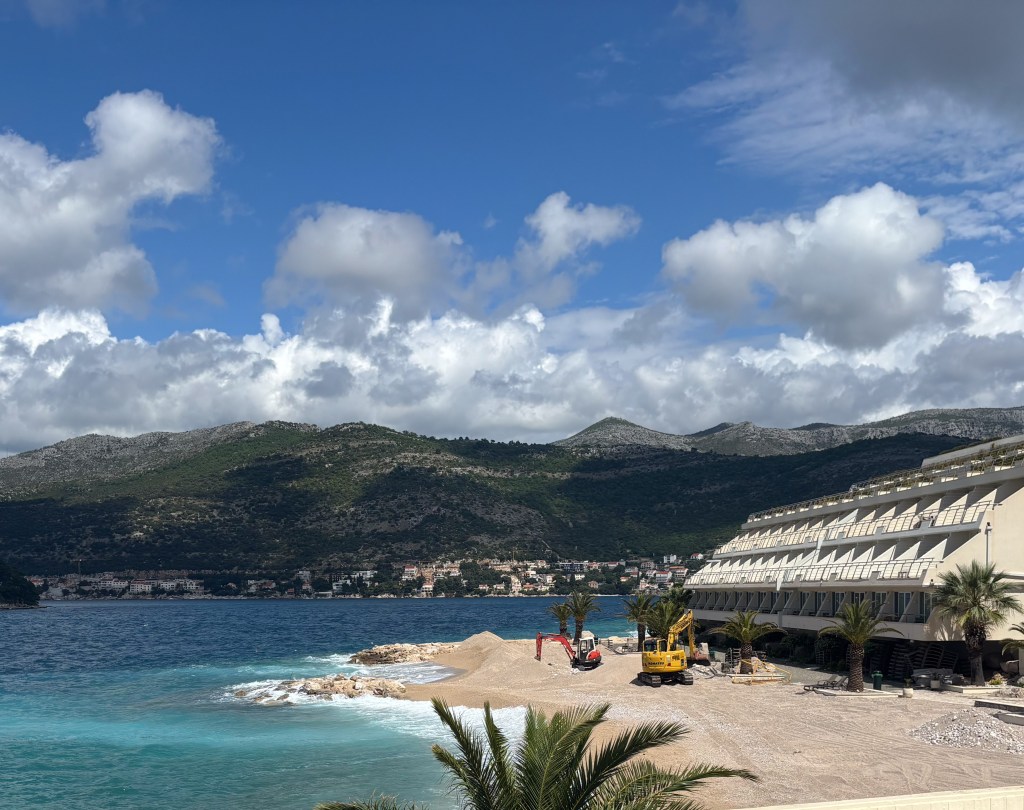


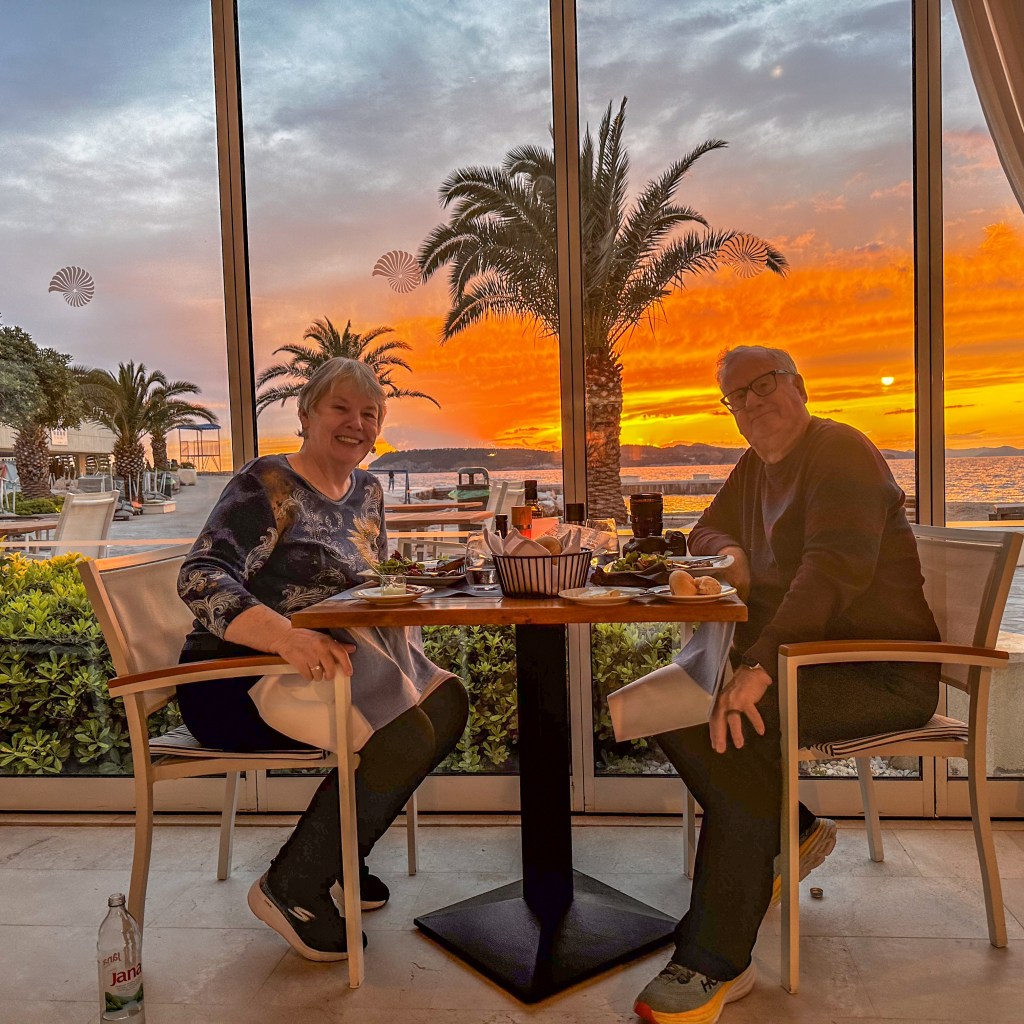
We’re still doing a good job of pacing ourselves, so we took it easy the first day
(easy to hunker down in the rain!) and, once the sun came out, we walked along
the sea wall, enjoying the huge waves that poured over parts of it in late
afternoon (above). This was the only time we saw anything but a placid Asiatic
Sea and we loved it! (Apparently the waves cause lots of damage to beachside
properties in the winter.) We also enjoyed the sunset! (How do you like my new palm hairdo?!?)
The next day we took another Tuk Tuk tour, this time in a larger, electric car with a couple from Ireland and another great guide. We learned a lot about the history of Croatia as we drove past the marinas and up to Mount Srd (and the top of a cable car run) to see Old Town from a different
perspective. All of Dubrovnik revolves around this unique center. It is contained within large walls built not only for defense, but also to keep the water out.

It was fun to see it from above before taking a walking tour through its squares,
narrow streets and alleyways, past many cafes, bars & souvenir shops. (It seems
like there are more places selling jewelry than anywhere else we’ve been…not
sure why.) We learned that there are 40 churches within Old Town’s walls—one
is Greek Orthodox and all the others are Catholic. Dubrovnik has had many
earthquakes, so, for safety, no balconies are allowed on the main streets. All the
streets are paved with limestone, which has become quite smooth over many
centuries. There was a bit of a connection to ancient times as we walked along,
imagining all who have walked here before us over such a long period of time.


The town’s architecture displays very little evidence from the “Siege of
Dubrovnik” beginning in 1992, during which more than 2,000 bombs were dropped on the
town. The only hint of this is the presence of all the newly-tiled terra cotta roofs.
There were lots of people in town and quite a bit of traffic as we drove inside. We
can’t imagine how chaotic it would be in high season (June-July-August), so we
would recommend May or September as the best time to come…warm enough
to enjoy all the beautiful beaches but easier to get around and enjoy all
Dubrovnik has to offer. We most always prefer quiet, so we’re glad we didn’t stay
where all the tourists are. AND, we can certainly see why this is called “The pearl
of the Adriatic.” The deep blue waters are stunning!
As you may know, Croatia is one of 6 republics that used to be called
Yugoslavia. The others are Bosnia & Herzegovina (including the city of Sarajevo),
Montenegro, Serbia (including the regions of Kosovo & Vojvodina), Slovenia &
Macedonia. All but the latter share borders with Croatia. As we were driving up to
the top of Mount Srd, I got a notice from Verizon welcoming me to Bosnia, and
found out the road briefly entered that country and everything to the east of us
was indeed Bosnia! That was a surprise! And so were the abundance of motor
scooters dodging in and out of traffic, often passing on both sides of the cars.
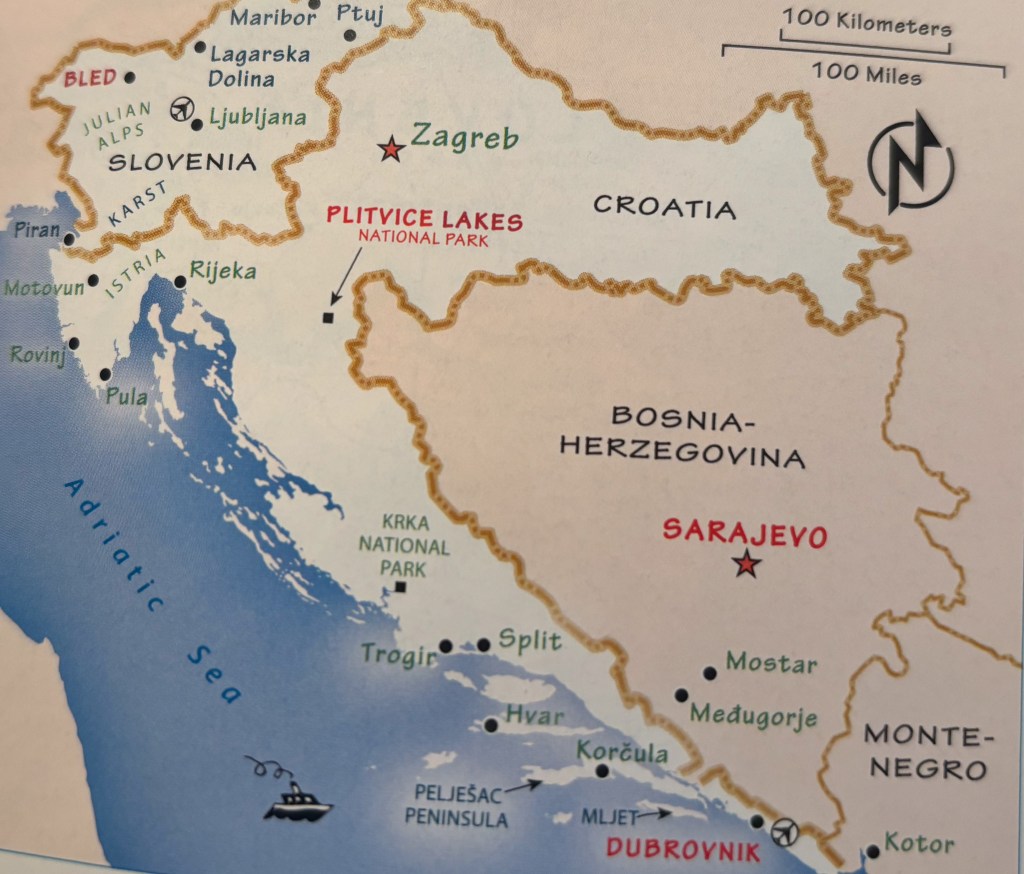
After a delightful 4 nights in Dubrovnik, we rented a car at the airport and headed
south over the Croatian border to Kotor, Montenegro (neighbors who’ve traveled
this area several times said it is “a must”). The roads were easy to drive (and
there weren’t any daredevil motor scooters this direction…yay). We’re glad we
weren’t in a hurry because the line of cars was very long at the border—it took us
over 1.5 hours to get through; they stamped our passports without question as
we left Croatia and again (1 mile later) as we entered Montenegro. We followed
the main road that wends its way through a variety of small seaside towns along
the coastline of a very steep-walled bay on a fjord-like inlet from the Adriatic Sea.
We stopped for a late lunch at a special restaurant in Morinj highly recommended
by my nephew Frank (Kanoba Catovica Mlini). The food was delicious and the
setting was especially memorable as we wandered along wooden pathways and
bridges enjoying its “magical ambiance” of small creeks, ponds and landscaping
as well as pairs of mallard ducks and geese.
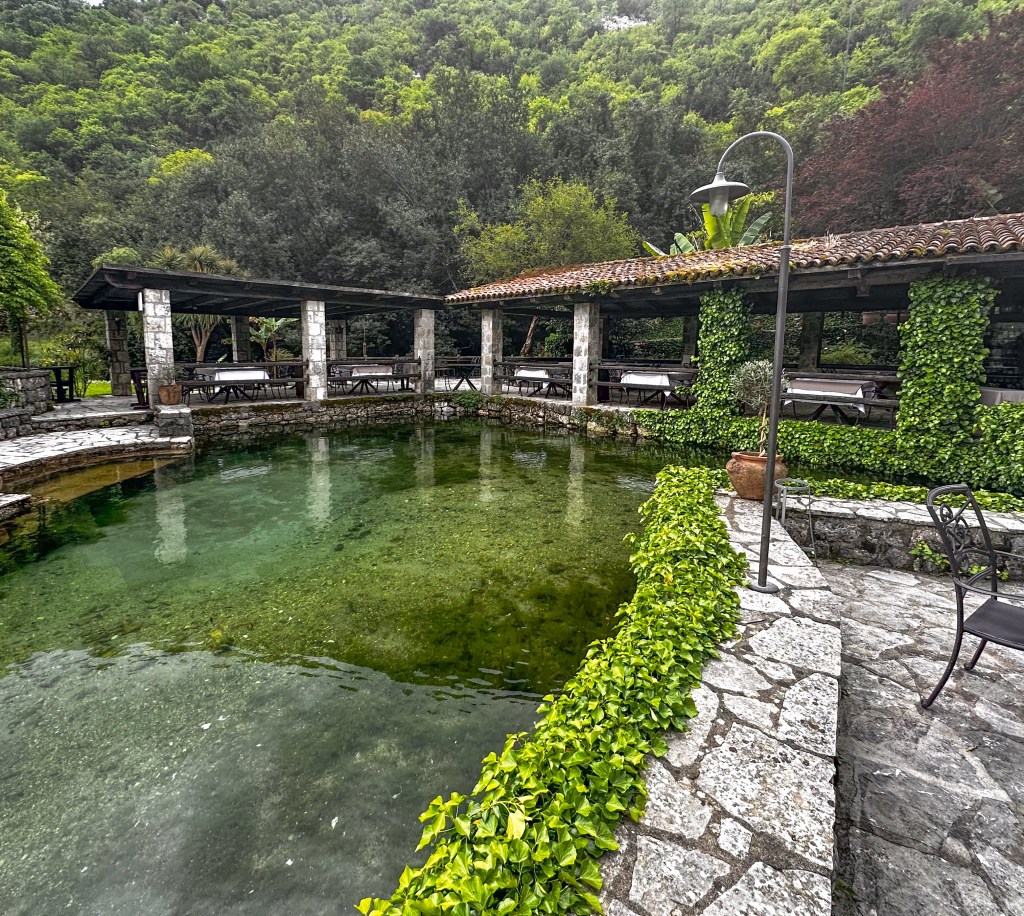
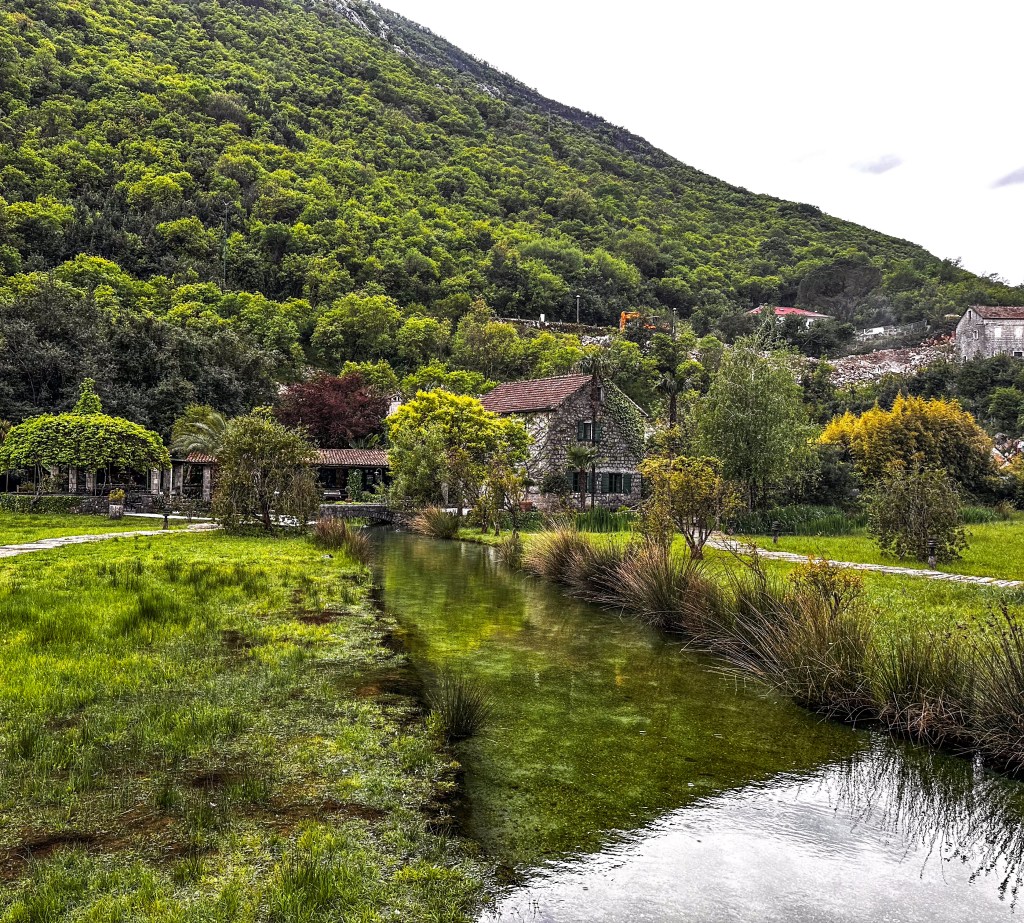
We finally got to our hotel late in the afternoon, having driven through several
more small seaside towns plus the heart of Kotor and its walled Old Town
complex overlooking the very calm and peaceful Bay of Kotor. Some call this
“little Dubrovnik,” but it feels much different. Yes, it overlooks the water, and yes,
there is a walled-in Old Town and yes, there are many red-tiled roofs, but the
whole town butts up against huge mountains filled with a maze of fortifications
that climb zigzag right up the sheer cliffs. We got a better look of it from across
the Bay as we were leaving (below)…you can barely see Kotor (in the middle)
tucked between the calm waters and the sheer mountains.
There are lots of trees and lots of churches (mostly Orthodox, a few Catholic).
One of the things we’ll always remember about Kotor is the ringing of old-fashioned church bells every hour from 7am to 9pm (and more often Sunday morning). It got very cold and rainy the day we’d planned to do some touring, we chose to stay in and relax (Gary’s been a bit under the weather & had some eye troubles, which we now think was a reaction to down pillows in Dubrovnik.)
We did go out for a wonderful late lunch at a nearby steak house and that was
quite the experience: steaks were individually wrapped and aging in a refrigerator
right in the dining room and we picked out the steak they then cooked and served
us. They were huge, so we split one. It was delicious!



SIDE NOTE: A friend wrote and suggested we “enjoy The Balkans,” and I must
confess I wasn’t sure what that meant. Hooray for Google! The Balkans takes its
name from the Balkan mountains that stretch throughout the whole of Bulgaria. It
is a geographical area in southeastern Europe, corresponding partially with the
Balkan Peninsula, bordered by the Adriatic Sea (NW), the Ionian Sea (SW),
the Aegean Sea (S), the Turkish Straits (E) and the Black Sea (NE). By most
definitions the Balkans encompass Albania, Bosnia & Herzegovina, Bulgaria,
Greece, Kosovo, Montenegro North Macedonia, European Turkey, most of
Serbia and large parts of Croatia. Sometimes the term also includes Romania
and southern parts of Slovenia and perhaps the Province of Trieste in Italy. It’s
fun to research and find out about things I’m not sure of as we travel along!
We plan to spend the next ten days exploring lots more of Croatia. Stay tuned!
I sent your post to our dear neighbor friends because Alec was born in Bosnia and his wife,, Hope, is from the U.S., They met when she worked in Bosnia for several years for a U.S. gov’t. agency. Her comments are as follows:
“Thank you for sharing Elizabeth! The Croatian and Montenegrin coast are spectacular. We’ve spent a lot of time there and often think about retiring there. Actually wish we had bought some land there back when the war ended as prices have skyrocketed. Even hotel stays are off the charts. We also stayed at the Dubrovnik President when I lived in Bosnia back then, and it only cost us $25 a night in the middle of summer as people were too scared to visit. Now it is $400. One day we will take Alec (he’s their 10-year old son they adopted from China) there so he can also enjoy it.”
Their son is brilliant and also quite an athlete. He’s particularly good at baseball (a pitcher) and soccer. Plus, he plays chess on line and is a voracious reader.
Love, Elizabeth and Tom
LikeLike